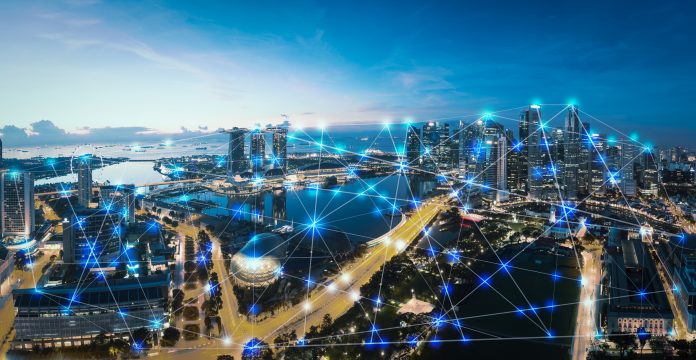PBC Today talks to Robert Mankowski, vice-president of digital cities at Bentley Systems, about how digital twins can help to plan, design, build and operate smarter infrastructure
Robert Mankowski is vice-president of digital cities, the newest of infrastructure engineering software, Bentley Systems’ four business units. It is responsible for helping cities, and the organisations that own and operate the infrastructure in and between cities, to achieve sustainable growth, increase their resilience and increase the safety, health and welfare of their citizens by going digital.
PBC Today sat down with him to discuss the rise of digital twins and how they can contribute to building smarter cities.
How do digital twins bring together data from different sources and, more importantly, integrate that data to help shape city services?
Cities typically have infrastructure information spread throughout their organisations. Different departments have different systems for managing the data associated with their specific workflows and infrastructure assets, and some city infrastructure is owned and operated by private parties.
The data exists in a variety of formats – CAD, BIM and GIS, engineering models, spreadsheets, databases, documents, real-time and historic IoT data streams, photos and point clouds, to name just a few broad categories.
The data changes all the time, and one of the biggest problems owner-operators face is getting the right, up-to-date information to make informed decisions. It’s been difficult and time-consuming to get the data when it’s needed. It has also been difficult to integrate it across these departments and organisations to form a holistic view of the city’s infrastructure assets and systems.
With Bentley iTwin® Services, an open-source framework for creating infrastructure digital twins, cities can federate data – whatever the engineering applications and BIM tools, repositories and file systems, or file formats and schemas might be.
This federated approach includes engineering data, CAD, BIM, GIS and reality data, CityGML, open data formats, other legacy data and operations data into an actionable digital twin of the city. Additionally, this can include real-world conditions – IoT-connected devices/sensors. Then, the city can manage and collaborate city infrastructure information in every stage of the asset lifecycle from planning to performance.
With this federated information, cities can manage the data associated with and generated by the infrastructure assets.
This open, connected data environment (CDE) supports ongoing operations and maintenance, and:
- Reduces resources spent on costly data aggregation and integration.
- Makes relevant information accessible, reliable, and usable. You can quickly locate documents and reuse them with confidence (with the latest, most accurate information) and create information for one purpose and use it elsewhere – supporting key city initiatives.
- Supports planning through to operations with data-driven analysis, simulation and results.
- Improves asset definition, configuration, geospatial location and change management throughout the asset lifecycle.
- Saves money by extending the life of assets and equipment (actionable insights/predictive maintenance).
Where can the CDE and digital twins have the biggest impact in terms of planning, citizen engagement and transparency?
Cities want to improve urban planning with greater levels of detail and optimise the performance of existing assets. Cloud technology enables faster development, higher productivity, reduced costs and more secure environments for cities. Additionally, inefficient systems for communicating with citizens and stakeholders to get buy-in on city planning can slow input.
Cities need processes for getting quick buy-in and communicating plans in a comprehensive and visually aesthetic and compelling way – helping citizens understand the impact of plans to their lives, stay informed of ongoing projects – potentially improving their safety and helping to avoid commuting congestion near project sites, and allowing them a way to provide input. Bentley, working closely with strategic partner Microsoft, delivers solutions on Azure, tapping cloud technology to realise the potential of real-time business insights and collaboration for greater efficiency.
Bentley’s reality modelling solutions and open solutions deliver a rich environment for planning to stream large-scale digital twins online and visualise projects spanning entire cities down to the street level using a combination of terrain models, reality meshes and semantically rich 3D city models such as CityGML.
And cities can easily share and communicate urban planning and development projects with stakeholders and citizens. Cities can provide a fast, easy and visual way to successfully communicate, promote and share city projects in an interactive way to gain citizen buy-in and attract investors.
And, by providing a more immersive experience for stakeholder and citizen engagement, cities can improve communication and collaboration across departments, with city ecosystems and with citizens – delivering on the promise of greater transparency and improved engagement.
This could include state-of-the-art technologies that deliver digital experiences (mixed reality and wearables), or visualisation and crowdsourcing through devices such as web, mobile, touchscreens and digital billboards.
How do digital twins improve city resilience and in particular what are the benefits of having near real-time data?
City resilience is the capacity of the city, its citizens and its systems to withstand the kinds of chronic stresses and acute shocks they experience. At Bentley, we focus on the stresses and shocks that impact city infrastructure, which of course have major impacts on the quality of life of the city’s citizens.
Extreme hydrometeorological events are one of those shocks that, combined with rapid urbanisation and inadequate draining substructures, trigger flooding and cause major damage to infrastructure, impact human safety and weaken the economy.
Flood resilience refers to comprehensively managing flood risks to minimise impacts and rapidly recover from disruptions caused by a flood event. Bentley’s flood resilience solution for urban, riverine and coastal systems brings accurate and reliable risk and analysis data to agencies involved in flood preparedness, response, recovery and mitigation. Through infrastructure digital twins, cities get advanced and integrated flood modelling and simulation that enables the understanding and mitigation of flood risks of the complex array of interconnected processes related to urban, riverine and coastal systems. Bentley’s reality modelling solutions, along with its open solutions, provide the ability to perform risk assessment at city scale including what-if scenarios and post-event emergency triage.
Using digital twins for flood resilience provides decision-makers with real, actionable information towards anticipated early warning and prompt response and can be used in the emergency management cycle of preparation, response, recovery and mitigation.
Resilience teams can make the right decisions using actionable insights to anticipate early warning and promote response to increase public safety and decrease damage to infrastructure, while minimising service interruption, avoiding additional mitigation cost and improving response times.
Furthermore, with the help of Bentley OpenFlows™ solutions, city utilities can evaluate current infrastructure and improve resilience plans that could include evaluating flood risk and improvements to operations. Additionally, utilities can use information from the scenarios to define mitigation strategies including cost-benefit analysis of changes to utility systems to mitigate future system issues.
How important is having the right culture alongside the technology to get the most out of a digital city?
It’s quite well known that in general, it’s very difficult, if not impossible, to execute a successful digital strategy without the right culture, the right technology and the right business processes. And, in many ways, the right culture is the most important part.
The people of an organisation will be tasked with implementing the digital strategy, so putting their needs at the heart of the strategy gives them the incentive and motivation to move the initiative forward. What problems do they have that technology can solve? Until that question is truly answered, implementing new processes and technology is inefficient at best.
A digital twin of a city is only powerful when it is being used to drive new insights and inform better decisions. This requires a culture that puts an emphasis on data-informed decision making and business processes that leverage infrastructure digital twins.
Robert Mankowski

Vice-President, Digital Cities
Tel: +44 (0)207 861 0900
Twitter: @BentleySystems
LinkedIn: Bentley-systems
Facebook: BentleySystems
YouTube: BentleySystems
Instagram: Bentleysystems














